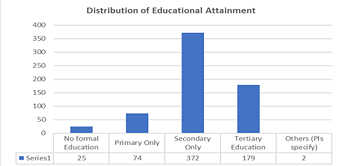Self-Medication of Prescription Only Non-Steroidal Anti-Inflammatory Drugs among Households in Alimosho LGA, Lagos State, Nigeria

Abstract:
The
purpose of this study is to determine the knowledge, attitude, and practice of self-medication
of NSAIDs among adults in Alimosho Local Government Area (LGA) of Lagos State. The
study is descriptive inferential form cross-sectional study that involved collection
of data from adults in the LGA. The data collected from questionnaires administered
to adults who were randomly selected across the LGA was analyzed to evaluate the
association between demographic characteristics and knowledge, attitude, and practice
of self-medication. The respondents who participated in the research were adults
who were 18 years and above. Of the 652 respondents 50.8% were males and while 49.2%
were females. Demographic profile and Information sources were tested for association
with self-medication. Among respondents, 80.6% admitted that they are self-medicated,
and a binary logistic regression was performed to ascertain the effect of gender,
age, marital status, and educational attainment on the likelihood of respondents
engaging in self-medication. The overall logistic regression was statistically significant,
χ2 (1) = 24.824, p< 0.005. The model explained 10.2% (Nagelkerke R2)
of the variance in self-medication and correctly classified 80.4% of cases.
References:
[1] NAFDAC Green Book https://greenbook.nafdac.gov.ng/
(Accessed 11 October 2022).
[2] Batlouni M. (2010) Nonsteroidal anti-inflammatory drugs: cardiovascular,
cerebrovascular, and renal effects. Arq Bras Cardiol. 2010;94(4):556-563.NAFDAC
2020.
[3] Boelsterli U. 2002 Mechanisms of NSAID-induced
hepatotoxicity: focus on Nimesulide. Drug Safety, 25(9):633-648. DOI: 10.2165/00002018-200225090-00003.
PMID: 12137558.
[4] Masubuchi Y., Yamada
S., Horie T. 2000 Possible mechanisms of hepatocyte injury induced by diphenylamine
and its structurally related NSAIDS. J Pharmacol Exp Ther. 292:982–987.
[5] NAFDAC 2019 Drug and related product labelling
regulations 2019 https://www.nafdac.gov.ng/wp-content/uploads/Files/Resources/Regulations/All_Regulations/Drug-and-Related-Product-Labelling-Regulations-2019.pdf.
[6] NAFDAC 2021 Drug And Related Products Labelling
Regulations, 2021 https://www.nafdac.gov.ng/wp-content/uploads/Files/Resources/Regulations/Regulations_2021/Drug-and-Related-Product-Labelling-Regulations-2021.pdf
(Accessed 27 May 2022).
[7] ALG (n.d) Alimosho Local Government Area in
Metro Lagos https://www.citypopulation.de/php/nigeria-metrolagos.php?cid=NGA025003.
[8] Wejnert, C., Pham, H., Krishna, N., Le, B.,
and DiNenno, E. 2012 Estimating design effect and calculating sample size for respondent-driven
sampling studies of injection drug users in the United States. AIDS and behavior,
16(4), 797–806. https://doi.org/10.1007/s10461-012-0147-8.
[9] Charan J., and Biswas T. 2013 How to calculate
sample size for different study designs in medical research, Indian journal of
psychological medicine, 35(2), 121–126. https://doi.org/10.4103/0253-7176.116232.
[10] CSPro 2022 Census and Survey Processing System (CSPro)
Online
Available https://www.census.gov/data/software/cspro.html
(Accessed
March 2021).
[11] Bruce N., et al. 2008 Quantitative
research methods for health research: a practical interactive guide to epidemiology
and statistics. Chichester, UK: Wiley.
[12]
Motola
D., Vaccheri A., Silvani M. C., et al. 2004 Pattern of NSAID use in the Italian
general population: a questionnaire-based survey. Eur J Clin Pharmacol,60(10):731–8.
[13]
Shafie,
M., Eyasu, M., Muzeyin, K., Worku, Y., & Martín-Aragón, S. 2018 Prevalence,
and determinants of self-medication practice among selected households in Addis
Ababa community. PloS one, 13(3), e0194122. https://doi.org/10.1371/journal.pone.0194122.
[14]
Bidmon, S. and Terlutter, R. 2015 Gender Differences
in Searching for Health Information on the Internet and the Virtual Patient-Physician
Relationship in Germany: Exploratory Results on How Men and Women Differ and Why
Journal of Medical Internet Research 2015,
Volume 17, No 6: e156 (Accessed 01 October 2021).
[15]
Ek, S. 2013 Gender
differences in health information behaviour: a Finnish population-based survey Online available at: http://heapro.oxfordjournals.org/content/early/2013/08/28/heapro.dat063.full.pdf+html
(Accessed 01 October, 2015).
[16] Esan D.T. 2018 “Assessment of Self-Medication
Practices and Its Associated Factors among Undergraduates of a Private University
in Nigeria”, Journal of Environmental and Public Health, vol. 2018, Article
ID 5439079, 7 pages, 2018. https://doi.org/10.1155/2018/5439079.
[17]
Bennadi, D. 2013 Self-medication: A current challenge. Journal of
Basic and Clinical Pharmacy, 5(1), 19. https://doi.org/10.4103/0976-0105.128253.
[18] Kumari R., Kumar
D., Bahl R., and Gupta 2012 Study of knowledge and practices of self-medication
among medical students at Jammu. Journal of Medical Sciences, 15 (2):141-144.
[19] Gupta P., Bobhate P., and Shrivastava S. 2011 Determinants of self-medication practices in an urban slum community Asian Journal of Pharmaceutical and Clinical Research, 4 (3):54-57.
[20] Saha, A. et al. 2022 Risk factors associated with self-medication among the indigenous communities of Chittagong Hill Tracts, Bangladesh https://doi.org/10.1371/journal.pone.0269622.
[21] Asakitikpi,
A. E. 2019. Healthcare Coverage and Affordability in Nigeria: An Alternative Model
to Equitable Healthcare Delivery. In (Ed.), Universal Health Coverage. IntechOpen.
https://doi.org/10.5772/intechopen.85978.
[22] Bart J.
and Por M. et al. 2012 Addressing access barriers to health services: an
analytical framework for selecting appropriate interventions in low-income Asian
countries, Health Policy, and Planning, 27(4):288–300, https://doi.org/10.1093/heapol/czr038.
[23] McLeod S. 2019 What’s the difference
between qualitative and quantitative research? https://www.simplypsychology.org/qualitative-quantitative.html.
[24] Cline R.J. and Haynes K. M. 2001 Consumer health
information seeking on the Internet: the state of the art, Health Education
Research, 16 (6):671–692, https://doi.org/10.1093/her/16.6.671.
[25]
WHO, Royal
Tropical Institute and University of Amsterdam. (2007). How to improve the use
of medicines by consumers, Tercera edición. World Health Organization. https://apps.who.int/iris/handle/10665/69681.

